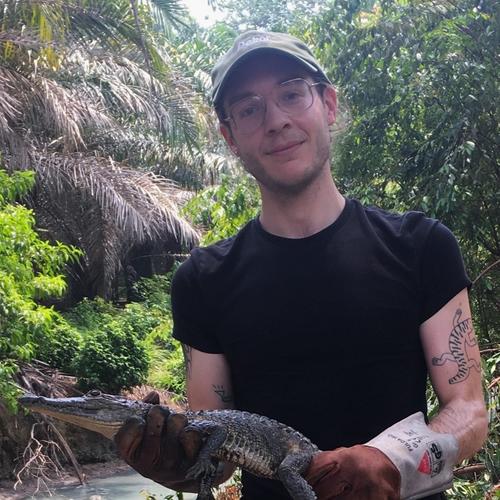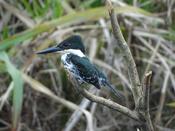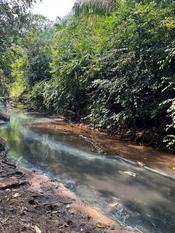Korbinian Pacher
The behavioral biologist studies schools of fish to investigate the effectiveness of collective movement patterns as protection against predators and the emergence of collective intelligence. He collaborates with the CE Science of Intelligence.
May 08, 2024
Large animal collectives like fish schools or bird flocks are among the most spectacular sights in nature. Looking at the perfect synchrony in which the collective moves becomes even more fascinating when we think about that this is achieved by individuals with relatively simple interaction rules and without centralised leadership. The question what an individual gains from being part of such a collective is often answered simply with: protection from predators. And while this is certainly true, we know only little about its actual functionality, namely how this form of protection works in the wild.
In my PhD project as an Elsa Neumann Fellow I aim to explore some of the open questions regarding this adaptive value of collective behaviour by using a field based approach in a unique study system: The collectively waving sulphur mollies (Poecilia sulphuraria) of southern Mexico. Sulphur mollies are small freshwater fish that have evolved two unique features: They can thrive in toxic sulphur springs where dissolved oxygen is almost absent and when attacked by predatory birds their shoals show a repeated collective diving behaviour that creates travelling surface waves decreasing attack frequency and success of their predators. In filming these sulphur molly shoals and their predators in the field and by using computer vision-based approaches to quantify their behaviour in the lab I hope to gain valuable insights on the generality of a collective anti-predator response, the spatial factors influencing the effectiveness of such behaviours and the presence of emergent collective intelligence.
I am Korbinian Pacher, a first-year doctoral researcher at the department of ecology of fishes at the Thaer institute at Humboldt University. My project is centred around an annual field season in southern Mexico. Here I join the team of my supervisor Prof. Dr. Jens Krause with researchers from the Excellence Cluster Science of Intelligence (SCIoI), IGB Berlin and the university of Tabasco in Villahermosa, Mexico. We conduct our field observations at the El Azufre riverine system, a small river that is directly connected to geothermally heated sulphur springs. The high temperatures and sulphur content render these waters toxic to most aquatic organisms and so the sulphur molly is one of two fish species that can survive under these conditions. While they have to fear almost no interspecific resource competition and no aquatic predators (like for example predatory fish) this environment confronts these fish wit substantial challenges. The dissolved H2S and high temperatures (of up to 36°C) deplete the water of oxygen, so during the day the sulphur fish must perform aquatic surface respiration at which they exploit the water layer that is constantly in contact with air and therefore saturated with oxygen. This leads to massive shoals of up to several million individuals at the surface during the day, which naturally attract predators from outside the water in the form of various bird species.
Over twenty species of birds are known to prey on these surface bound shoals of sulphur mollies among them many specialised piscivores such as herons and kingfishers. To cope with this high predation pressure sulphur mollies have developed a unique defence: They dive down collectively and repeatedly which leads to surface waves created by the tailbeat of thousands of synchronously diving fish. These waves spread and travel through the shoals and have been shown to have a predator deterring effect: Bird that see these waves are more likely to wait longer between their attacks or change hunting location. In one species these waves were even shown to have a negative effect on hunting success.
For us as researchers this system is a unique opportunity to study collective behaviour in the wild. The waves represent a collective anti-predator behaviour that can easily be quantified through simply counting waves or automatically track them for insights on a much finer scale. In addition, we can observe frequent predation by different species on the same prey group continuously in the field (which is normally really challenging) an have a direct link between predator behaviour and prey response. And thirdly can the collective waving be triggered experimentally, which means we can simulate different predatory cues and investigate the response of the fish in the field. We work as an interdisciplinary team on various aspects of this system. While my colleagues from SCIoI are more interested in the properties and factors that shape and enable such a unique collective behaviour as well as its implications for theoretical models of information transmission and processing, my focus lies more on predator prey interactions.
Upon the completion of my PhD I hope to have gained insights into the following questions: Does a prey collective show a predator specific response or does one collective behaviour work on all different predators? Both possibilities have interesting implications as a specialised response would raise questions regarding the ability of fish shoals to discriminate between predators. A generalized response on the other hand would imply that the collective waving exploits some kind of general weakness in the sensory system of all predators. Further I aim to examine how the spatial factors, namely where in a shoal a bird attacks, influence the collective prey response. By exploring this I hope to find the answer to the question which position in a group is safest and if predators have the mean to counter a collective response by dynamically adjusting their attack location.







